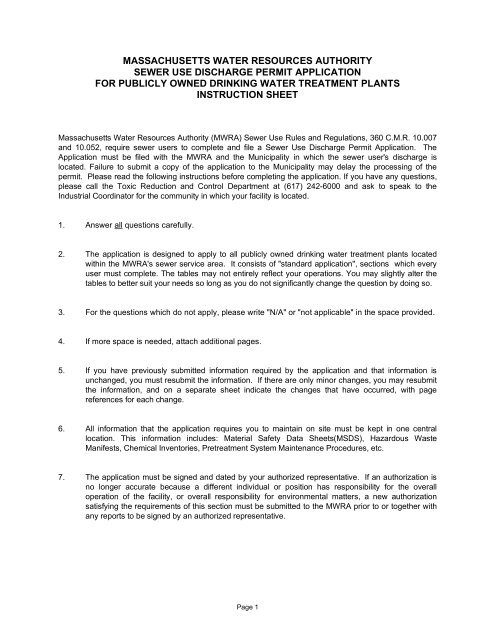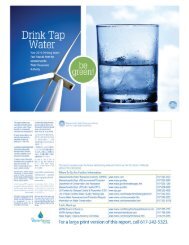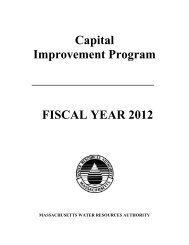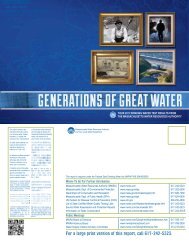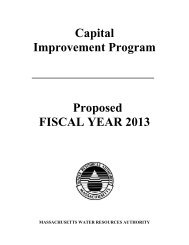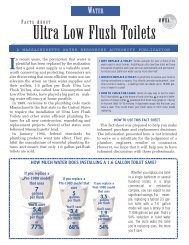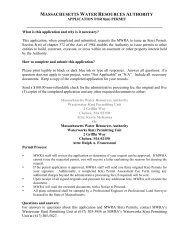massachusetts water resources authority sewer use discharge ...
massachusetts water resources authority sewer use discharge ...
massachusetts water resources authority sewer use discharge ...
Create successful ePaper yourself
Turn your PDF publications into a flip-book with our unique Google optimized e-Paper software.
MASSACHUSETTS WATER RESOURCES AUTHORITYSEWER USE DISCHARGE PERMIT APPLICATIONFOR PUBLICLY OWNED DRINKING WATER TREATMENT PLANTSINSTRUCTION SHEETMassach<strong>use</strong>tts Water Resources Authority (MWRA) Sewer Use Rules and Regulations, 360 C.M.R. 10.007and 10.052, require <strong>sewer</strong> <strong>use</strong>rs to complete and file a Sewer Use Discharge Permit Application. TheApplication must be filed with the MWRA and the Municipality in which the <strong>sewer</strong> <strong>use</strong>r's <strong>discharge</strong> islocated. Failure to submit a copy of the application to the Municipality may delay the processing of thepermit. Please read the following instructions before completing the application. If you have any questions,please call the Toxic Reduction and Control Department at (617) 242-6000 and ask to speak to theIndustrial Coordinator for the community in which your facility is located.1. Answer all questions carefully.2. The application is designed to apply to all publicly owned drinking <strong>water</strong> treatment plants locatedwithin the MWRA's <strong>sewer</strong> service area. It consists of "standard application", sections which every<strong>use</strong>r must complete. The tables may not entirely reflect your operations. You may slightly alter thetables to better suit your needs so long as you do not significantly change the question by doing so.3. For the questions which do not apply, please write "N/A" or "not applicable" in the space provided.4. If more space is needed, attach additional pages.5. If you have previously submitted information required by the application and that information isunchanged, you must resubmit the information. If there are only minor changes, you may resubmitthe information, and on a separate sheet indicate the changes that have occurred, with pagereferences for each change.6. All information that the application requires you to maintain on site must be kept in one centrallocation. This information includes: Material Safety Data Sheets(MSDS), Hazardous WasteManifests, Chemical Inventories, Pretreatment System Maintenance Procedures, etc.7. The application must be signed and dated by your authorized representative. If an authorization isno longer accurate beca<strong>use</strong> a different individual or position has responsibility for the overalloperation of the facility, or overall responsibility for environmental matters, a new authorizationsatisfying the requirements of this section must be submitted to the MWRA prior to or together withany reports to be signed by an authorized representative.Page 1
An authorized representative of a municipality includes:a) a responsible public official, including a Mayor, City Manager, Town Administrator, Chair of theBoard of Selectman, District Manager, or any other person who performs similar policy or decisionmakingfunctions for the municipality or Water District, or the director, manager, or superintendent ofthe department responsible for operating or overseeing the operation of the Water Treatment Plant,if <strong>authority</strong> to sign documents has been assigned or delegated to the individual in accordance withthe munipality's procedures.b) the duly authorized representative of the individual designated in (a) of this section if:i) the authorization is made in writing by the individual described in (a);ii) the authorization specifies either an individual or a position having responsibility forthe overall operation of the facility from which the dishcarge originates, such as the positionof plant manager, operator of a well, or well field superintendent, or a position of equivalentresponsibility, or having overall responsibility for environmental matters for the municipality;iii)the written authorization is submitted to the MWRA.8. Note that Section C, Question 5, of this application requires that the applicant complete a hydraulicanalysis of the <strong>sewer</strong> system which will receive the effluent from the <strong>water</strong> treatment plant. Thisanalysis, required for all proposed <strong>discharge</strong>s, must be prepared under the direction of aprofessional engineer registered in the Commonwealth of Massach<strong>use</strong>tts, and be submitted with theapplication.9. Submit the original completed form and four (4) copies to the MWRA and a copy to the Municipalityat the address below. Keep a copy for your own records.10. You must submit a completed application no later than (60) days before your current permit expiresfor your current permit to remain in effect pending a decision on your new application.MWRA ADDRESS:MUNICIPAL ADDRESS:Massach<strong>use</strong>tts Water Resources Authority2 Griffin WayChelsea, MA 02150-3334Attention: TRACPage 2
MASSACHUSETTS WATER RESOURCES AUTHORITYSEWER USE DISCHARGE PERMIT APPLICATIONFOR PUBLICLY OWNED DRINKING WATER TREATMENT PLANTSSECTION A - GENERAL INFORMATION1. Name of Facility:2. Permit/MailingAddress:3. Billing Address:Billing Contact:4. Facility Address:5. How long has the facility been at this address?6. Facility representative to contact concerning information provided herein:Name:____________________________ Title: _____________________________________Telephone:__________________________ Address: ___________________________________Telefax:____________________________ ___________________________________7. Name and Title of Preparer (if different from #6 above):Name:____________________________ Title: _____________________________________Company:______________________________________________________________________Telephone:__________________________ Address: ___________________________________Telefax:____________________________ ___________________________________8. Name and Title of Authorized Representative (if different from #6 above):Name:______________________________ Title: ___________________________________Telephone:_________________________ Address: ___________________________________Telefax:______________________________________________________________9. Name of Person to Receive Permit (if different from #6 above):Name:______________________________ Title: ___________________________________Telephone:_________________________ Address: ___________________________________Telefax:_____________________________________________________________10. Check One: _____ New Permit _____ Renewal PermitIf New Permit, provide date of proposed initial <strong>discharge</strong> __________Page 3
SECTION B - CERTIFICATION STATEMENT AND SIGNATUREI certify under penalty of law that this document and all attachments were prepared under mydirection or supervision in accordance with a system designed to assure that qualified personnel properlygather and evaluate the information submitted. Based on my inquiry of the person or persons who managethe system, or those persons directly responsible for gathering the information, the information submitted is,to the best of my knowledge and belief, true, accurate, and complete. I am aware that there are significantpenalties for submitting false information, including the possibility of fine and imprisonment for knowingviolations.DateSignature of Authorized RepresentativePlease Print Name of Authorized RepresentativeName of FacilityStreet Address of FacilityCity State Zip CodePage 4
SECTION C - HYDRAULIC CAPACITYThe applicant must complete this section to demonstrate that there is adequate capacity in the <strong>sewer</strong>system to accept the <strong>discharge</strong> of <strong>water</strong> treatment plant residuals without negatively effecting the operationof the municipal and MWRA <strong>sewer</strong> systems. For each question, please indicate the source of theinformation.1a. Describe each municipal <strong>sewer</strong> that will receive the proposed <strong>discharge</strong>(s). Include connectionlocation, section number, size, slope, material, etc. for each proposed <strong>discharge</strong>. (Attach additionalpages if necessary.)1b. Provide the following information for each municipal <strong>sewer</strong> that will carry the <strong>discharge</strong>:Estimated Design Capacity Existing Flow Total Flow with newConnection_____________MGD ________Minimum MGD ________Minimum MGD________Average MGD________Peak MGD________Average MGD________Peak MGD1c. Provide the following flow information on the proposed <strong>discharge</strong>:Average daily flow:______________ gallons per day (gpd)Peak one day flow:_______________ gpdAverage flow rate:_______________ gallons per minute (gpm)Peak flow rate:__________________ gpm2. Describe the MWRA <strong>sewer</strong> that will receive the proposed <strong>discharge</strong>(s). The information shallinclude connection location and section number for each proposed <strong>discharge</strong>. MWRA <strong>sewer</strong>system information can be found by contacting the Director of Transport, Sewerage Division,MWRA, at (617) 305-5921.Page 5
SECTION C - HYDRAULIC CAPACITY (continued)3. List the municipal <strong>sewer</strong>age pumping stations downstream of the proposed <strong>discharge</strong> and providethe following information (in million gallons per day):Name & LocationPumping CapacityAverage PeakExisting FlowsAverage PeakProposed FlowsAverage Peak4. If a municipal <strong>sewer</strong> does not have adequate capacity to transport peak dry or wet weather flows,provide with this application a report describing how the proposed <strong>discharge</strong>(s) will be controlled toinsure that the downstream <strong>sewer</strong> system will not surcharge during dry and/or wet weather eventsand that the capacity of downstream municipal pumping stations will not be exceeded.5. This application must be supported by a hydraulic analysis prepared under the direction of andstamped by a professional engineer registered in the Commonwealth of Massach<strong>use</strong>tts. Theanalysis must demonstrate that the proposed <strong>discharge</strong> will not adversely affect the municipal <strong>sewer</strong>system.Note:The MWRA will perform a hydraulic analysis of the proposed <strong>discharge</strong> to determine the effect of the<strong>discharge</strong> on the MWRA system, including impacts to combined <strong>sewer</strong> overflows. If the MWRAdetermines that the proposed <strong>discharge</strong> will have an adverse impact on the MWRA system, theApplicant will be required to submit a report describing how the proposed <strong>discharge</strong> will becontrolled to insure no adverse impacts.Page 6
SECTION D - PLANT OPERATIONAL CHARACTERISTICS1. Operational Information:a. Total operating hours per work day _________b. Number of operating shifts per day _________c. Number of employees per first shift_________second shift________third shift_________d. Number of operating days per week __________e. Average annual work days per year __________f. Number of employees _______2. If the operation is subject to seasonal variation, please describe:3. Does the facility implement any of the following management plans?(Indicate yes or no for each):_____ Spill Prevention and Control and Countermeasure Plan_____ Source Reduction Plan_____ Toxicity Reduction Evaluation_____ Toxic Organic Management Plan_____ Filter Backwash RecyclingPage 7
SECTION E - WATER USAGE1. Water Sources:Provide the name and location of the <strong>water</strong> source(s) of the drinking <strong>water</strong> being treated.What is the amount (in gallons) of <strong>water</strong> treated per day from each source?Are the amounts measured or estimated? If estimated, how was the estimate determined?2. Has the incoming <strong>water</strong> to the treatment plant been analyzed within the past year? If so,please attach a copy of the most recent results.Page 8
SECTION F - CHEMICAL USAGE/OTHER PERMITS1. List chemicals and raw materials <strong>use</strong>d in the facility that could contribute to waste<strong>water</strong>s <strong>discharge</strong>dto the sanitary <strong>sewer</strong> system. List only those present in quantities of 5 gallons/5 pounds or greater.Include MSDS documents and chemical analyses of the chemicals and materials.Chemical/MaterialQuantity Used PerYearChemical/MaterialQuantity Used PerYear2. Have you prepared a Toxic Chemical Release Inventory reporting form, (Form R) in response to theSuperfund Amendment and Reauthorization Act (SARA) section 313?Yes____No ____3. Please maintain at your facility in one centralized location, reports that indicate usage of chemicalscovered under the Superfund Amendment and Reauthorization Act (SARA) Title III, including thequantities <strong>use</strong>d per year.Examples of reports that should be maintained if they exist, and made available upon MWRArequest, include:Biennial DEP ReportInventories with Local Fire DepartmentsSARA Title III ReportReports required under TURAOther Reports/Inventories which would illustrate chemical usagePlease list the reports that you maintain at your facility:________________________________________________________________________________________________________________________________________________________________________________________________________________________Page 9
SECTION F - CHEMICAL USAGE/OTHER PERMITS (continued)4. Please list all other environmental permits held for the facility and all environmental permits not nowheld by the facility that it requires. For each permit, indicate issuance date, expiration date, andpermit number. If a permit has not yet been issued or has expired, indicate the date of your latestapplication for the permit.Page 10
SECTION G - SEWER CONNECTION(S) AND PIPING & INSTRUMENTATIONDIAGRAM1. Attach a drawing/map of the facility showing all buildings and identify the operations conducted ineach building. In the buildings from which process waste<strong>water</strong> <strong>discharge</strong>s, label alphabetically the<strong>sewer</strong> connections to which the processes <strong>discharge</strong>. Also label the nearest downstream manholewith the same letter. Indicate if both process and sanitary waste<strong>water</strong> <strong>discharge</strong> through a commonconnection. Name all surrounding streets and buildings, and any other pertinent physical structuresthat may facilitate field orientation. Note that if you propose to connect directly into a pipe owned bythe MWRA, you must adhere to the policies and procedures of the MWRA's direct connectionprogram, which requires the completion and filing of a direct connection permit application. Thisapplication can be obtained by calling the MWRA Sewerage Division, Director of Transport, at (617)305-5921.2. Attach a Piping and Instrumentation Diagram (P & I D) of your facility. The P & I D should be aschematic of all tanks, process equipment, pretreatment equipment, flow and pH meters, pipes andvalves. The P & I D should show the paths of all pipes, and all <strong>discharge</strong> points to the <strong>sewer</strong> andstorm drains - including sumps and floor drains. Identify <strong>sewer</strong> connections as you did in thedrawing/map of the facility.Page 11
SECTION H - NON-DISCHARGED WASTE1. Are any waste liquids or sludges removed from the facility site? Yes____ No____If yes, they may be best quantified as:Waste TypeEstimated Gallons/YearWaste SolventWaste ProductOilGreaseTreatment SludgeThinnerAcids and AlkalisPesticidesOther______________________2. State the name and address of any waste hauler(s) employed by your company.A: B:3. Are there any sludges, liquids or spill clean up materials placed with the trash for disposal?Yes______ No_____Describe discarded waste:_________________State name and address of hauler for this waste:4. Does your facility employ the service of a commercial laundry? Yes______ No________5. State name and address of the company:Page 12
SECTION I - DRINKING WATER TREATMENT OPERATIONS1. Please describe the drinking <strong>water</strong> treatment operations at your facility including: the <strong>water</strong> sourceand chemicals <strong>use</strong>d in the operations; filter material; volume of filter material expected to be<strong>discharge</strong>d annually; per cent (%) solids of residuals; method of residuals <strong>discharge</strong>, (includingstorage capacity and a continuous low flow feed rate) and backwash and recycling operations.2. Do you have any operations in addition to drinking <strong>water</strong> treatment at or adjacent to your facility,e.g., vehicle maintenance, equipment maintenance, laboratory, etc., that have a <strong>sewer</strong> <strong>discharge</strong>?If yes, provide a description of each including the chemicals associated with each operation.Page 13
SECTION J - WASTEWATER DISCHARGE* For more than one <strong>discharge</strong> location, please make copies of this page.1. Previously permitted sampling location number if applicable ____________ (If new application,please leave sampling location number blank.)2. Complete the following chart and provide descriptions on the following page:Type ofDischargeWater TreatmentRelatedFlow(GPD)indicatewhethermeasuredorestimatedAve PeakProposed %solids in the<strong>discharge</strong>AveMaxSanitarySewerConnectionfrom yourmapDoeswaste<strong>water</strong>Discharge toStorm Drain orSurfaceWater?Is DischargeBatch(describefrequency andduration) orContinuous?1. Sludge2. Backwash3. ReverseOsmosis RejectWaterNon-WaterTreatmentRelatedXXXXXXXXXXXXXXXXXXXXXXXXXXXXXXXXXXXXXXXXXXXXXXXXXXXXXXXXXXXXXXXXXXXXXXXXXXXXXXXXXXXXXXXXXXXXXXXXXXXXXXXXXXXXXXXXXXXXXXXXXXXXXX1. Non ContactCooling WaterXXXXXXXXXXXXXXXXXX2. Boiler Blowdown XXXXXXXXXXXXXXXXXX3. Air PollutionWaste<strong>water</strong>4. ProcessWaste<strong>water</strong> otherthan DrinkingWater Treatment(describe source)5. SanitaryWaste<strong>water</strong> 1Other:XXXXXXXXXXXXXXXXXXXXXXXXXXXXXXXXXXXXXXXXXXXXXXXXXXXXXXXXXXXXXXXXXXXXXXXXXXXXXXXXXXXXXXXXXXTotalXXXXXXXXX1 human and domestic waste from such sources as lavatories, showers, and kitchens.How is waste<strong>water</strong> flow measured?If estimated, how did you arrive at the estimated amount?Page 14
2a. Describe here how sludge is generated and identify the contributing sources.2b. Describe how backwash is generated.2c. Describe the sources of other process waste<strong>water</strong> streams generated at the facility.3. Are any process changes planned for the next two years which would affect the <strong>discharge</strong> volumeor characteristics? yes___no___ If yes, briefly describe these changes and their affects on the<strong>discharge</strong> volume and characteristics. Include treatment modifications, variations in <strong>discharge</strong>volume, and additional <strong>sewer</strong> connections.Page 15
SECTION J - WASTEWATER DISCHARGE (continued)4. Does any wastestream have a flow measuring device? ____YES _____NOWhich ones? ______________________________A. If yes, check type of meter or device (and indicate location of device):_____WeirType of Weir:_____ V-Notch _____60 _____45 _____30 _____22.5_____ Contracted Rectangular Sharp Crested Weir (with end contractions)_____ Suppressed Rectangular Sharp Crested Weir (without end contractions)_____ Parshall Flume size ____________ Magmeter_____ Venturi Meter_____ Other _______________B. If no, is there a reason for not installing a flow measuring device?NOTE: If you do not have a flow measuring device, you will be required by your permit to install one.Page 16
SECTION K - WASTEWATER CONSTITUENTS*(For more than one process <strong>discharge</strong>, make copies of these pages)1. Check the conventional, toxic and hazardous pollutants expected to be present in your waste<strong>water</strong> <strong>discharge</strong>for each process connection. If you are unable to identify the characteristics you must submit MSDS torepresent the characteristics of each process <strong>discharge</strong>.In addition, you must sample your proposed <strong>discharge</strong> and submit analytical data showing allpollutants regulated by the MWRA at 360 CMR 10.021-10.024, expected to be present in thewastestream. All analyses must be performed by a DEP certified lab according to procedures set forthin 40 CFR Part 136. If there is no test method in Part 136 for a pollutant, contact the Permit section, at(617)241-2381 for information on acceptable test methods to <strong>use</strong>. The samples must represent the<strong>discharge</strong> after all pretreatment and prior to mixing with any other streams.Previously permitted sampling location number if applicable ____________________ (If new application, pleaseleave sampling location number blank)Provide average pH _______high pH _______ low pH ________Oil or grease (petroleum or mineral origin)AmmoniaTotal Suspended SolidsOil or grease (animal or vegetable origin) BOD 5VOLATILE COMPOUNDSACROLEINBENZENEBROMODICHLOROMETHANECARBON DISULFIDECHLOROBENZENE2-CHLOROETHYL VINYL ETHERCHLOROMETHANE1,1-DICHLOROETHANE1,1-DICHLOROETHENE1,2-DICHLOROPROPANEt-1,3-DICHLOROPROPENEMETHYLENE CHLORIDE1,1,2,2-TETRACHLOROETHANETOLUENE1,1,2-TRICHOLOROETHANEVINYL ACETATEACRYLONITRILEBROMOFORMBROMOETHANECARBON TETRACHLORIDECHLOROETHANECHLOROFORMDIBROMOCHLOROMETHANE1,2-DICHLOROETHANEt-1,2-DICHLOROETHENEc-1,3-DICHLOROPROPENEETHYLBENZENESTYRENETETRACHLOROETHENE1,1,1-TRICHLOROETHENETRICHLOROFLUOROMETHANEVINYL CHLORIDEXYLENEPage 17
SECTION K - WASTEWATER CONSTITUENTS (continued)ACID/BASE/NEUTRAL COMPOUNDSACENAPHATHENEANTHRACENEBENZO(A)ANTHRACENEBENZO(K) FLUORANTHENEBENZO(A)PYRENEBIS (2-CHLOROETHOXY) METHANEBIS (2-CHLOROISOPROPYL) ETHER4-BROMOPHENYL PHENYL ETHER2-CHLORONAPHTHALENECHRYSENEDIBENZOFURAN1,3-DICHLOROBENZENE3,3'-DICHLOROBENZIDINEDIMETHYL PHTHALATE2-METHYL-4,6-DINITROPHENOL2,6-DINITROTOLUENE1,2-DIPHENYLHYDRAZINEHEXACHLOROBENZENEINDENO (1,2,3-cd) PYRENE2-METHYLNAPHTHALATE3-METHYLPHENOL (m-CRESOL)NAPHTHALENEN-NITROSO-DI-N-PROPYLAMINEN-NITROSODIPHENYLAMINEPYRENEACENAPHTHYLENEBENZIDINEBENZO(B) FLUORANTHENEBENZO(GHI) PERYLENEBENZYL BUTYL PHTHALATEBIS (2-CHLOROETHYL) ETHERBIS (2-ETHYLHEXYL) PHTHALATE4-CHLOROANILINE4-CHLOROPHENYL PHENYL ETHERDIBENZO (A,H) ANTHRACENE1,2-DICHLOROBENZENE1,4-DICHLOROBENZENEDIETHYL PHTHALATEDI-N-BUTYL PHTHALATE2,4-DINITROTOLUENEDI-N-OCTYL PHTHALATEFLUORENEHEXACHLOROETHANEISOPHORONE2-METHYLPHENOL (o-CRESOL)4-METHYLPHENOL (p-CRESOL)NITROBENZENEN-NITROSODIMETHYLAMINEPENTACHLOROPHENOL1,2,4-TRICHLOROBENZENE2,4,5-TRICHLOROPHENOLPage 18
SECTION K - WASTEWATER CONSTITUENTS (continued)HAZARDOUS SUBSTANCESACETALDEHYDEALLYL CHLORIDEANILINEBENZYL CHLORIDEBUTYLAMINECYCLOHEXANEDIETHYL AMINEDIMETHYL AMINEETHYLENE DIBROMIDEISOPRENEMETHYL MERCAPTANMONOETHYL AMINENAPTHENIC ACIDPHOSGENEQUINOLINETRIETHANOLAMINE DODECYLBENZENESULFONATETRIMETHYLAMINEALLYL ALCOHOLAMYL ACETATEBENZONITRILEBUTYL ACETATECROTONALDEHYDE2,2-DICHLOROPROPIONIC ACID1,3-DINITROBENZENEETHYLENE DIAMINEFURFURALISOPROPANOLAMINEDODECYLBENZENESULFONATEMETHYL METHACRYLATEMONOMETHYL AMINENITROTOLUENEPROPYLENE OXIDERESORCINOLTRIETHYLAMINEXYLENOLPage 19
SECTION K - WASTEWATER CONSTITUENTS (continued)PESTICIDES/PCBsALDRINALPHA-BHCBETA-BHCGAMMA-BHCDELTA-BHCCHLORDANE4,4-DDT4,4-DDE4,4-DDDDIELDRINALPHA-ENDOSULFANBETA-ENDOSULFANENDRINENDRIN ALDEHYDEHEPTACHLORHEPTACHLOR EPOXIDEPCB-1242PCB-1254PCB-1221PCB-1232PCB-1248PCB-1260PCB-1016TOXAPHENEENDOSULFAN SULFATETOTAL METALSALUMINUMANTIMONYARSENICBERYLLIUMBORONCADMIUMCHROMIUMCOPPERLEADMERCURYMOLYBDENUMNICKELSELENIUMSILVERTHALLIUMZINC2. Please describe any expected seasonal variations in waste<strong>water</strong> constituents (what parameters areexpected to be present or absent, expected changes in concentrations, and when they are likely to occur).Page 20
SECTION L - WASTEWATER PRETREATMENT* (For more than one process <strong>discharge</strong> make copies of this page.)1. Previously permitted sampling location number if applicable _________ (If new application, pleaseleave sampling location number blank)2. Complete the following table for each treated process wastestream at your facility.1 Treated Wastestream2 Pretreatment3 DEP Classification ofPretreatment System4 Sewer ConnectionFrom MapKEY1-Treated WastestreamProvide a description of the treated wastestream.2-Pretreatmenta. Neutralization/pH adjustment f. Silver Recoveryb. Chemical precipitation g. Screen/Grit removalc. Sedimentation h. Grease Trapd. Filtration i. Gas/Oil Separatore. Ion exchange j. Other _____________3-Massach<strong>use</strong>tts Department of Environmental Protection (DEP) Pretreatment System Classification.List Class 1 through 5 to indicate the pretreatment system operator class required to operate your pretreatment system.4-Sewer ConnectionTake from F-1 on page 9 of this application.3. List name and DEP operator grades for all certified pretreatment system operators working atyour facility.Operator Name _______________________ Grade_____ Job Title________________Operator Name _______________________ Grade_____ Job Title________________Operator Name _______________________ Grade_____ Job Title________________Page 21
SECTION L - WASTEWATER PRETREATMENT (continued)4. List all the applicable Federal Categorical Pretreatment Standards established by the US EPA(Environmental Protection Agency), for your facility._______________________________________________________________________________________Page 22
OTHER FILINGS:There are circumstances when the MWRA cannot issue a permit to you until you fulfill the requirements ofanother agency. This page asks for information about whether you are required to file with theMassach<strong>use</strong>tts Historical Commission (MHC) or under the Massach<strong>use</strong>tts Environmental Policy Act(MEPA) and the status of your filing, if any. If you have any questions about the requirements of thoseagencies, please contact them for information: MHC may be reached at 617-727-8470; the MEPA officemay be reached at 617-727-5830.A. Is the activity for which you require an MWRA permit a part of a project that is likely to impact ageographic area and affect or ca<strong>use</strong> a change in the historical, architectural, archeological,or cultural qualities of a property as defined by the Massach<strong>use</strong>tts Historical Commission(MHC)? (Answer “no” if this notice is for an existing permit or you are not doing new construction.MHC defines “new construction” as a modification to the land or any existing structure.) yesno If “no,” skip question B.B. If your answer to question A is “yes:”(1) Have you provided the required project notification form (950 CMR 71, Appendix A) to theMHC? yes no(2) Briefly describe the status of the project with MHC. Provide documentation (see 950CMR 71.07) allowing the MWRA to act on this application. If you have not providednotice to the MHC, explain why you have not provided notice and when you willprovide notice.C. Is the activity for which you require an MWRA permit a part of a project that is subject to reviewunder the Massach<strong>use</strong>tts Environmental Policy Act (MEPA)? (Answer “no” if this notice is foran existing permit or not part of a larger project. The MEPA review thresholds are found in 301CMR 11.03.) yes no If “no,” skip question D.D. If your answer to question C is “yes”:(1) Have you made the required MEPA filing? yes no(2) Briefly describe the status of the MEPA review. Provide documentation (see 301 CMR11.12) allowing the MWRA to act on this application. If you have not filed with MEPA,explain why you have not filed and when you will file.END OF APPLICATIONPage 23


